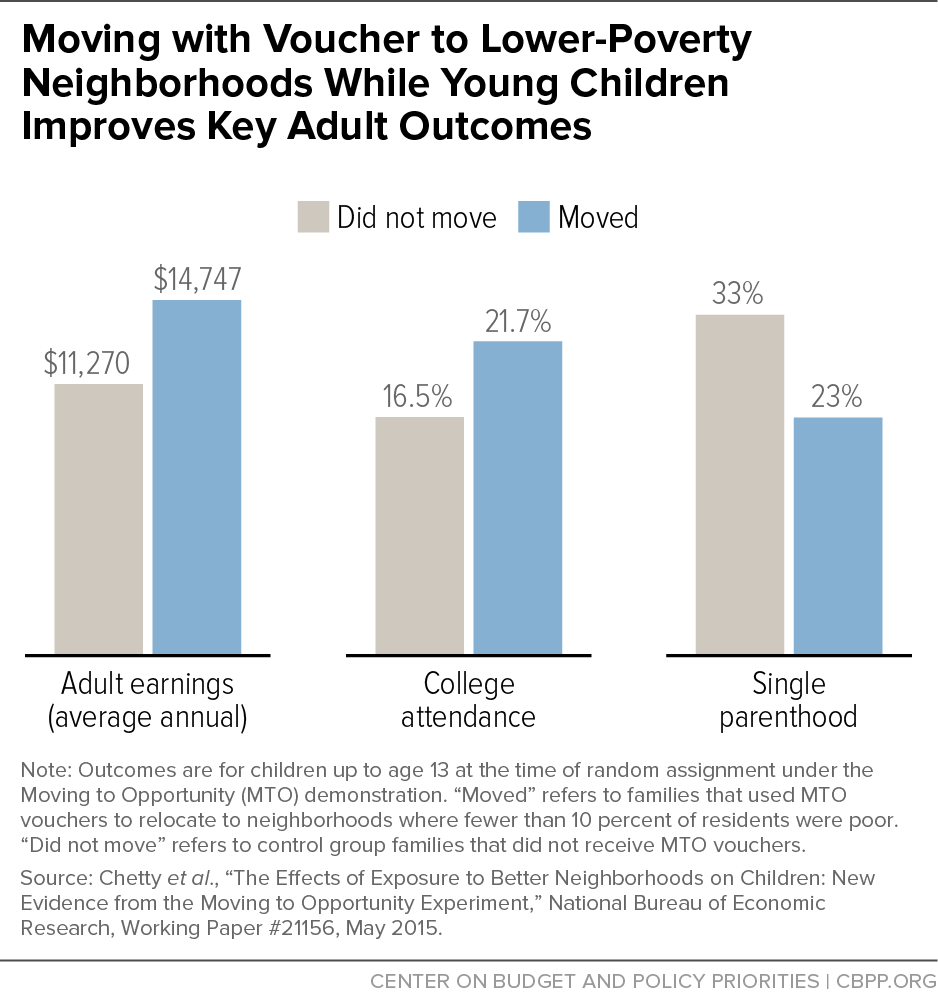BEYOND THE NUMBERS
The Department of Housing and Urban Development (HUD) should move quickly to refine and implement its proposal to expand a promising HUD policy that helps families with Housing Choice Vouchers rent in higher-opportunity areas by tying their voucher subsidies to rents in a particular neighborhood, rather than an entire metro area.
HUD finished accepting public comments this week on its plan, which would expand so-called Small Area Fair Market Rents (SAFMRs) to about 30 metro areas. HUD should implement the plan this year to give more low-income families access to low-poverty neighborhoods with low crime and strong schools.
Research shows that moving to low-poverty neighborhoods can sharply improve adults’ health and — as the graph shows — children’s life chances.
Today, most voucher subsidies are tied to fair market rents (FMRs) that HUD sets based on typical rents for modest units in a given metro area. But metro-level FMRs are often too low to enable families with vouchers to rent in high-opportunity neighborhoods. And they’re often higher than needed in poorer neighborhoods, which can allow owners there to charge above-market rents and allow families to rent units that are larger than they need or have more amenities than typical mid-market housing. This can encourage voucher use in neighborhoods with lower rents but more crime and worse schools.
SAFMRs, by contrast, are based on rents in individual zip codes, so they better match neighborhood rents. HUD first implemented SAFMRs in the Dallas area in 2010, and the evidence shows that they expanded opportunities for voucher holders without raising costs. Three years after the shift to SAFMRs in Dallas, families that used vouchers to move lived in neighborhoods with 17 percent less violent crime and poverty rates two percentage points lower than where they would have lived under metro FMRs, one study estimated.
HUD’s proposal would require state and local housing agencies to use SAFMRs to set voucher subsidies in metro areas where vouchers are disproportionately concentrated in low-income areas, and allow agencies elsewhere to voluntarily adopt SAFMRs. That’s a sound approach. But HUD should adjust its criteria for deciding where to require SAFMRs so they better target areas where they’d have the greatest benefits.
For example, in some tight housing markets where HUD’s proposal would require SAFMRs, such as New York City and parts of the San Francisco Bay area, housing agencies and advocates have raised concerns that — unlike in Dallas — many voucher holders wouldn’t be able to find units in high-rent zip codes due to intense competition for the few vacant units.
SAFMRs could be helpful in tight markets, but only if they’re accompanied by effective measures to help families use vouchers in high-opportunity neighborhoods — and making the needed changes would take time and money. HUD should drop housing markets with the lowest vacancy rates from the list of areas where it would require agencies to use SAFMRs during the proposed expansion.
HUD should also improve its proposal in other ways. For example, in zip codes where the SAFMR is much lower than the FMR, HUD should phase in the decline over several years so the amount of rent a voucher covers in those neighborhoods doesn’t drop too abruptly. In addition, a recently enacted law allows agencies to exempt families from subsidy declines stemming from SAFMRs or other FMR changes if they remain in the unit they now rent with a voucher, and HUD should make sure that agencies using SAFMRs understand this new option.

